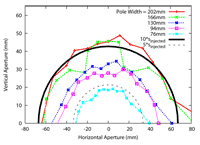Director's Corner
14 December 2006
 Gerry Dugan |
Cost Optimisation of Wigglers for the ILC Damping Rings
Today's issue features a Director's Corner from Gerry Dugan, GDE Americas Regional Director.
One of the key technical components of the ILC damping rings is the wiggler magnet, a device consisting essentially of a series of dipole magnets of alternating polarity. Wigglers are used to increase the synchrotron radiation damping rate, allowing the required emittance reduction to be achieved during the 200 ms (millisecond) that each bunch train is stored in the damping ring.
 Dynamic aperture in the ILC damping ring (OCS2 lattice) vs. wiggler pole width. |
 Jeremy Urban in the CESR tunnel at Cornell. |
The wigglers are technically challenging devices with a number of design constraints. In addition to providing the required rate of synchrotron radiation damping, the wigglers must not increase the equilibrium emittance or energy spread beyond the design values. Since their complex magnetic fields have substantial nonlinear terms that depend on the field strength, period and width of the wiggler, the detailed magnetic design must be done carefully so as not to limit the ring dynamic aperture. In addition, the synchrotron radiation produced in the wiggler must be properly handled, and the electron cloud effects in the wiggler must be controlled. Finally, because a considerable number of wigglers will be required (approximately 80 1.5 m long wigglers in each 6 km ring), the cost of the wigglers is significant, making it important to optimise the design.
The optimisation of the ILC damping ring wigglers has been the subject of the Ph.D. thesis of Jeremy Urban, a graduate student at Cornell University. As a starting point for his optimisation, Jeremy took the design of the superconducting wigglers used in CESR-c, the 2 GeV circular electron-positron collider at Cornell. These wigglers have operated very well in the CESR-c machine, and simulations verified that they were in fact over-designed for the ILC application. Jeremy studied how the CESR-c wigglers could be redesigned to reduce the total wiggler length (and thus the cost of the system), while maintaining the required damping rate, equilibrium emittance, energy spread, and dynamic aperture. At the same time, he increased the wiggler gap to simplify some of the engineering challenges related to the vacuum and cryogenic systems. The final result was a reduction of 30% in the total wiggler length, with the expectation of a roughly similar corresponding reduction in the system cost.
Jeremy has documented the results of this work in his thesis and will graduate as a newly-minted Cornell Ph.D. in January 2007. He summarised the essential features of his work for the ILC community in a web page. This work provides an excellent example of the kind of cost-optimisations that will be carried out for many more of the key ILC components after the completion of the ILC RDR, as the R&D and design program expands to provide a mature machine design that has been fully optimised for cost and performance.
-- Gerry Dugan